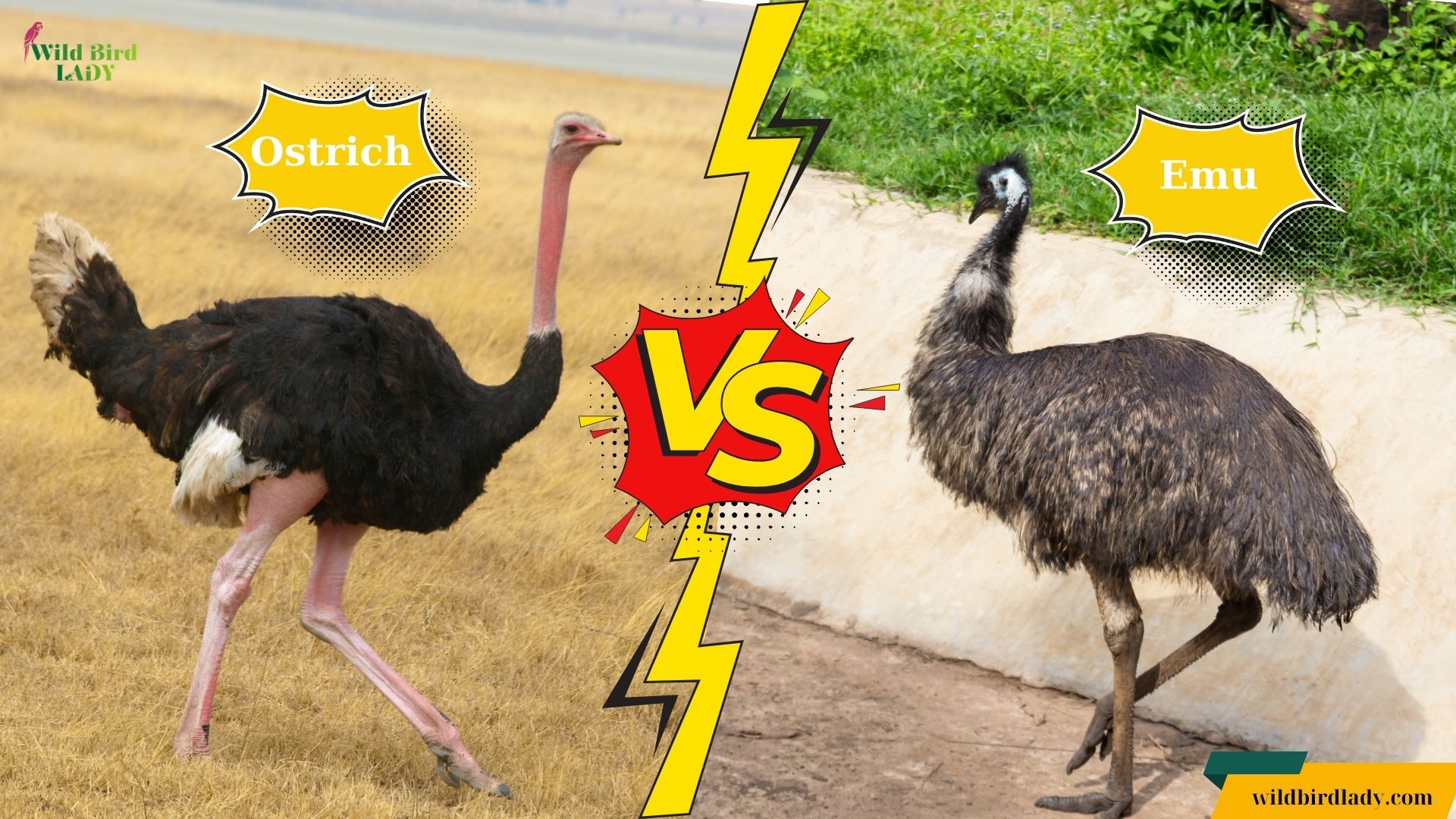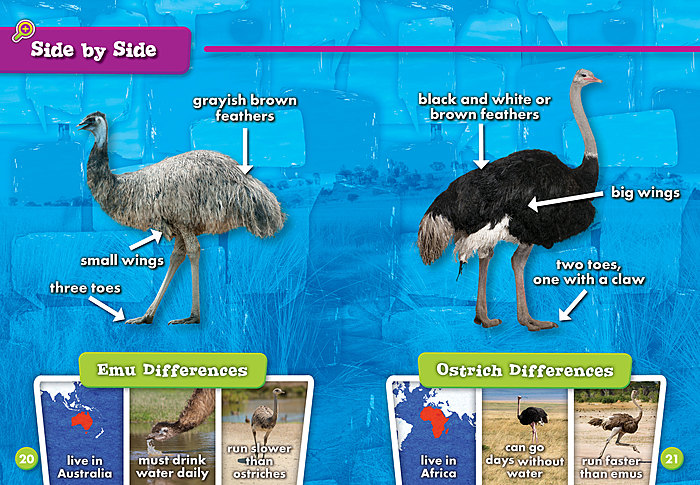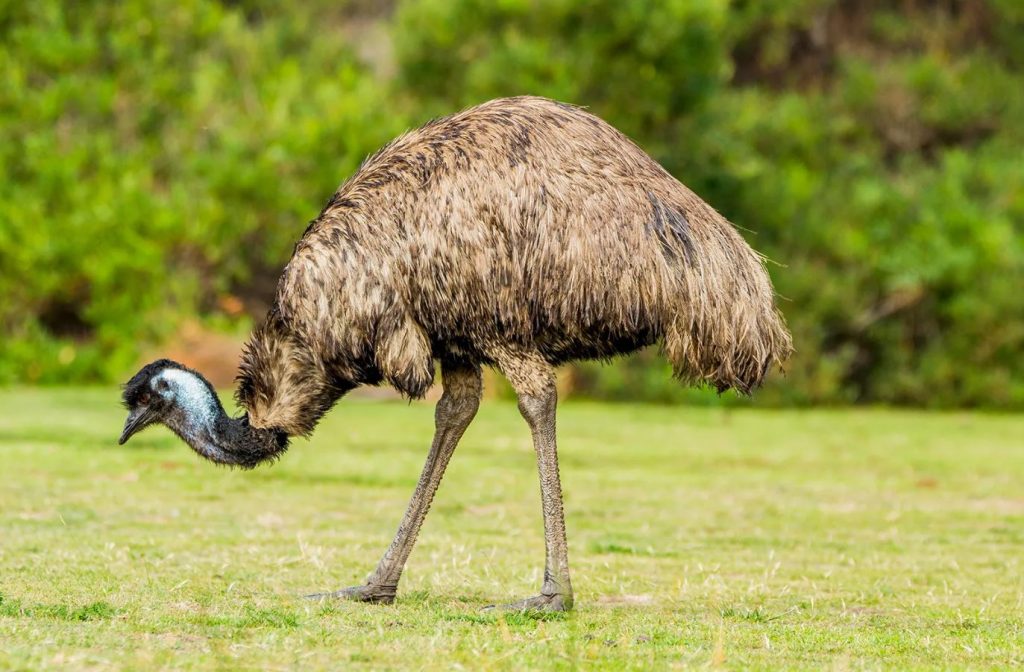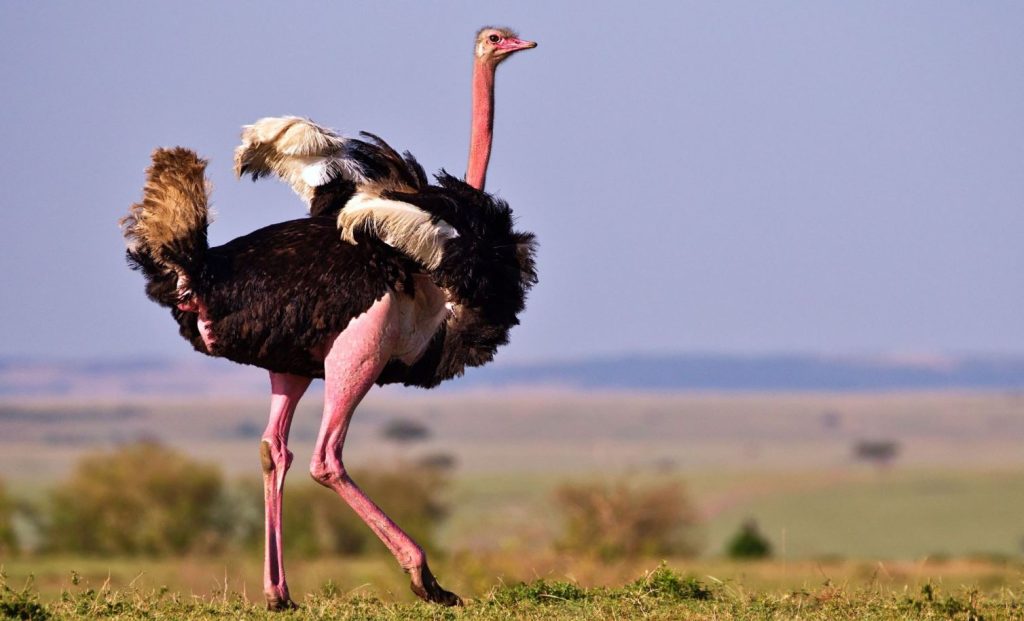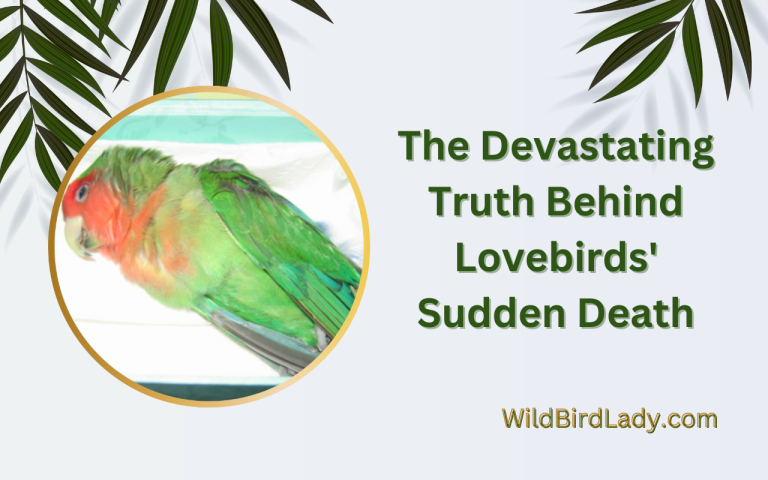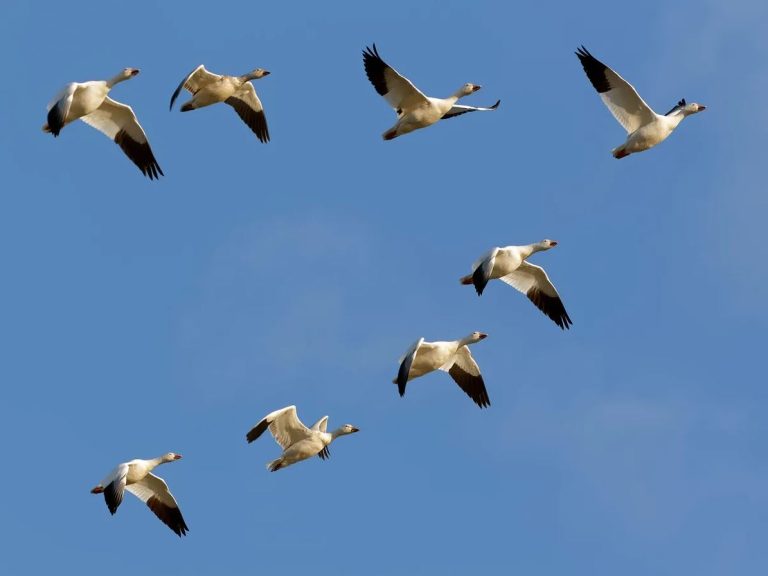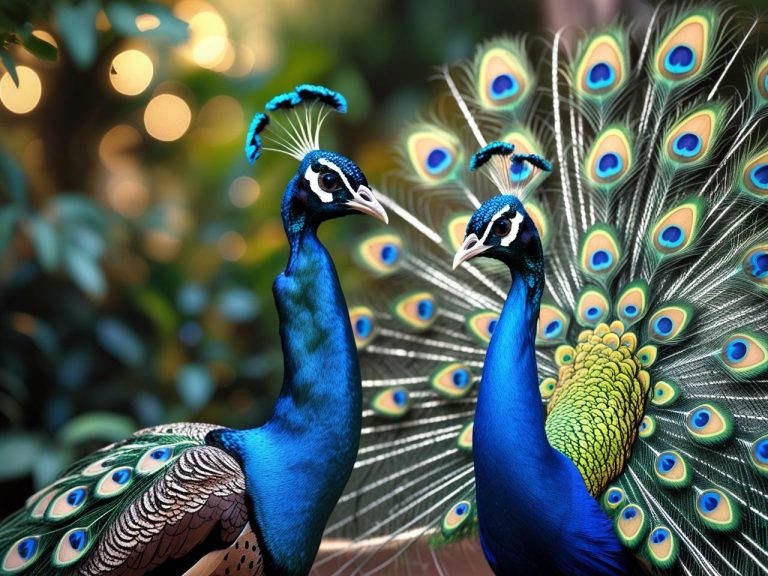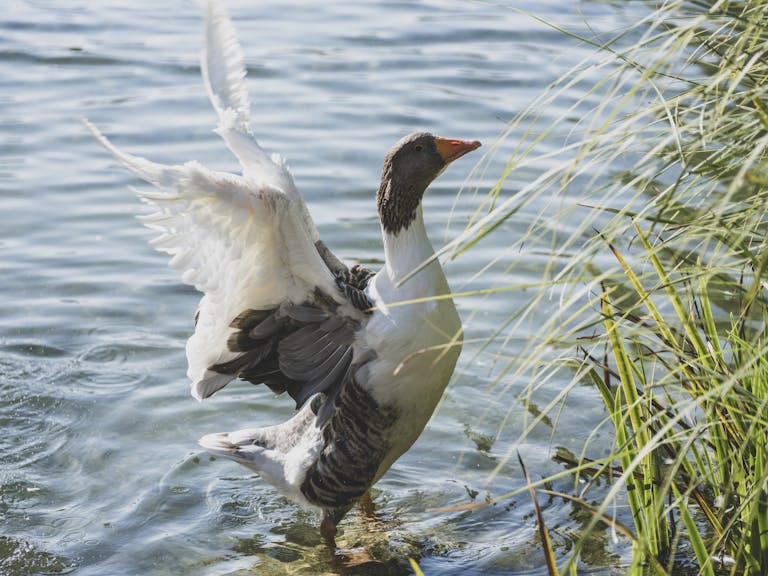Emu vs Ostrich: A Deep Dive into the World’s Largest Flightless Birds
When I first saw an emu striding across the arid grasslands of Western Australia, I was struck by its prehistoric presence. Years later, in the open savannas of South Africa, a towering ostrich reminded me just how diverse and fascinating flightless birds can be. Though both species belong to the ratite family—a group of flightless birds including cassowaries, rheas, and kiwis—the emu and ostrich are remarkably different in many ways.
In this comprehensive comparison, I’ll explore everything from size and speed to habitat, behavior, and evolutionary roots to help you truly understand the emu vs ostrich debate.
Quick Comparison Table
| Feature | Emu | Ostrich |
|---|---|---|
| Scientific Name | Dromaius novaehollandiae | Struthio camelus |
| Height | Up to 6.2 feet | Up to 9 feet |
| Weight | 66–100 lbs | 220–290 lbs |
| Top Speed | ~30 mph (48 km/h) | ~43 mph (70 km/h) |
| Native Region | Australia | Africa |
| Toes per Foot | 3 | 2 |
| Egg Size | Dark green, ~1 lb | Creamy white, ~3 lbs |
| Lifespan (wild) | 10–20 years | 30–40 years |
Taxonomy and Origins
Though emus and ostriches are both ratites, they diverged millions of years ago due to continental drift. Emus are native to Australia, while ostriches evolved in Africa.
- Emu (Dromaius novaehollandiae) is the second-largest bird in the world and the only living species in its genus.
- Ostrich (Struthio camelus) is the largest living bird and belongs to a genus that has fossil records dating back over 50 million years.
A study published in Science confirms that ratites like the emu and ostrich evolved flightlessness independently after their ancestors lost the ability to fly.
Physical Differences: A Closer Look
From a distance, it’s easy to confuse emus and ostriches—both are tall, flightless birds with long necks and legs, seemingly built for speed. But step closer, and their physical distinctions become impossible to miss. After years of observing both species in their native habitats, I’ve learned to recognize key features that set them apart.
Size and Build
One of the most obvious differences is size.
- Ostriches (Struthio camelus) are the undisputed giants of the bird world. Adult males can reach up to 9 feet (2.7 meters) in height and weigh between 220 and 290 pounds (100–130 kg). Their massive frame, long legs, and upright stance give them a commanding presence on the African plains. When you see an ostrich in the wild, it’s like watching a feathered dinosaur come to life.
- Emus (Dromaius novaehollandiae), while still large by bird standards, are much smaller. They stand around 5.7 to 6.2 feet (1.75–1.9 meters) tall and weigh roughly 66 to 100 pounds (30–45 kg). Their bodies are more slender, with a somewhat stooped posture and shaggy plumage that makes them look more rugged than regal.
From a birdwatching perspective, ostriches appear more muscular and upright, while emus give off a scruffier, more agile vibe.
Legs and Toes
Their legs—key to their survival—are another major difference.
- Ostriches have two toes per foot, a trait unique among living birds. The inner toe is large and thick, functioning almost like a hoof, and plays a crucial role in running. This adaptation allows them to sprint at speeds of up to 43 mph (70 km/h). Their long legs also serve as powerful weapons—an ostrich kick can seriously injure or even kill a predator like a lion.
- Emus, by contrast, have three toes on each foot, which gives them better stability and balance but reduces top-end speed. Their maximum running speed is around 30 mph (48 km/h). While not as fast as ostriches, emus can maintain their pace over longer distances, making them endurance runners of the outback.
When tracking footprints in the wild, toe count is one of the most reliable field markers I use to distinguish between the two.
Neck, Head, and Face
Both birds have long necks and small heads, but the details are telling.
- Ostriches boast the longest neck-to-body ratio of any bird, and their necks are almost completely bare, revealing pale or grayish skin. Their heads are relatively small but feature enormous eyes—up to 2 inches (5 cm) in diameter—making them the largest eyes of any land vertebrate. This gives them excellent vision to spot predators from far away. The beak is flat, broad, and slightly downturned.
- Emus have shorter, thicker necks covered in fuzzy, brown to gray feathers that give them a wooly appearance. Their skin is a bluish-gray, particularly around the base of the neck and face, which becomes more vibrant during the breeding season. Emu eyes are smaller and darker than those of ostriches, giving them a more curious and less intense expression. Their beaks are narrow, more pointed, and adapted for browsing vegetation.
Plumage and Coloration
Feather structure is another area of contrast.
- Ostrich feathers are loose and fluffy, almost hair-like, lacking the barbicels (hooks) that keep feathers neat and aerodynamic in flying birds. Males are typically black with white wing and tail plumes, while females are brownish-gray. Their feathers help regulate body temperature and provide insulation.
- Emus have shaggy, double-shafted feathers—a unique trait among birds—which gives them a coarse, almost fur-like appearance. Their coloring ranges from dark brown to light gray depending on age and environment, offering excellent camouflage in Australia’s scrublands and forests. Emu feathers also help dissipate heat, which is essential for survival in scorching outback climates.
These physical traits aren’t just cosmetic—they reflect millions of years of adaptation to two very different environments. The ostrich, designed for visibility, speed, and power in the open African savanna. The emu, built for endurance, stealth, and resilience in Australia’s unpredictable wilderness.
Seeing these birds side by side—or even just comparing photographs—reveals the beautiful diversity of avian evolution. When you learn to spot the details, you begin to understand not just what these birds are, but why they are the way they are.
Speed and Movement
If there’s one thing both birds excel at, it’s running.
- Ostriches are the fastest land birds in the world, reaching speeds of up to 43 mph (70 km/h). Their long, powerful legs allow them to cover up to 16 feet in a single stride.
- Emus are no slouches either. They can hit speeds of 30 mph (48 km/h) and use a swaying movement to maintain balance.
Despite their size, both birds have impressive agility and endurance.
Habitat and Range
Ostrich Habitat:
Ostriches inhabit African savannas, woodlands, and semi-arid regions. You’ll often spot them near water sources and in open fields where they can use their keen vision to detect predators from afar.
Emu Habitat:
Emus are found throughout mainland Australia, from grasslands to eucalyptus forests and deserts. They’re highly adaptable and often migrate in search of food and water.
Diet and Feeding Habits
Both birds are omnivores, though their diets vary based on local availability.
Ostriches:
- Primarily herbivorous—feeding on seeds, shrubs, and grasses.
- Will eat insects, lizards, or small rodents when available.
I’ve written an in-depth article about the diet of ostriches that you can check out here.
Emus:
- More opportunistic.
- Eat a wide range of fruits, flowers, insects, and even small vertebrates.
I’ve written an in-depth article about the diet of Emus that you can check out here.
According to Australia’s Department of Agriculture, emus swallow pebbles to help grind plant material in their gizzard, much like chickens.
Reproduction and Parenting
This is one area where both birds show fascinating—and quite different—reproductive strategies.
Emu Reproduction:
- Females lay up to 15 large, dark green eggs, but males incubate them.
- The male emu fasts and sits on the eggs for about 8 weeks, rarely leaving the nest.
- Once hatched, the male raises the chicks alone.
Ostrich Reproduction:
- Females lay their eggs in a communal nest, with one dominant female laying first.
- The male ostrich and dominant female take turns incubating up to 60 eggs.
- Chicks hatch after 42–46 days and are raised by both parents.
Behavior and Temperament
Emus:
- Generally shy and curious.
- Rarely aggressive unless cornered.
- Often travel in loose flocks, especially during migration.
Ostriches:
- Can be territorial, especially during breeding season.
- Known for their strong kicks, which can be deadly to predators.
- More assertive and less tolerant of human interaction.
While observing ostriches in the wild, I’ve learned to never approach during mating season—they will defend their territory aggressively.
Human Interaction and Domestication
Both birds have been farmed, though ostriches are more widely domesticated due to their size and meat.
Ostriches:
- Farmed for meat, feathers, and leather.
- Ostrich leather is especially prized for its durability and unique texture.
Emus:
- Farmed mostly in Australia and the U.S. for emu oil, which is used in cosmetics and traditional medicine.
- Emu meat is lean and considered a healthy red meat alternative.
Conservation Status
Both birds are not endangered, but their wild populations face threats from habitat loss and climate change.
- Ostriches are listed as Least Concern by the IUCN, though subspecies like the North African ostrich (Struthio camelus camelus) are critically endangered.
- Emus are also Least Concern, but regional populations can fluctuate depending on drought and land development.
Final Thoughts: Which Is More Impressive?
If you ask me to choose a favorite, I honestly can’t. Both birds are evolutionary marvels.
- The ostrich’s speed, strength, and size make it a formidable presence on the African plains.
- The emu’s resilience, unique parenting role, and adaptability to Australia’s harsh climate make it equally remarkable.
What they share is a deep evolutionary lineage that continues to fascinate scientists and birdwatchers alike.
FAQs
Q1: Can emus and ostriches live together?
A: Not naturally. They evolved on different continents and have distinct environmental needs. In captivity, mixing the two is discouraged due to size and behavioral differences.
Q2: Which bird lays the biggest egg?
A: The ostrich holds that record. An ostrich egg can weigh over 3 pounds and is the largest of any living land animal.
Q3: Are emus or ostriches more aggressive?
A: Ostriches are generally more aggressive, especially during the breeding season. Emus are more docile and avoid confrontation.
Q4: Do either of them fly?
A: No. Both are flightless birds, a trait they share with other ratites like cassowaries and kiwis.
Q5: Which bird is faster—emu or ostrich?
A: Ostrich. They can reach 43 mph, while emus top out around 30 mph.
If you ever get the chance to see both these magnificent birds in their native environments, I highly recommend it. There’s nothing quite like watching an ostrich sprint through the savanna or an emu wander silently through the outback. Their stories, like the continents they call home, are both ancient and awe-inspiring.

